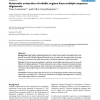Free Online Productivity Tools
i2Speak
i2Symbol
i2OCR
iTex2Img
iWeb2Print
iWeb2Shot
i2Type
iPdf2Split
iPdf2Merge
i2Bopomofo
i2Arabic
i2Style
i2Image
i2PDF
iLatex2Rtf
Sci2ools
BMCBI
2007
2007
Automatic extraction of reliable regions from multiple sequence alignments
Background: High quality multiple alignments are crucial in the transfer of annotation from one genome to another. Multiple alignment methods strive to achieve ever increasing levels of average accuracy on benchmark sets while the accuracy of individual alignments is often overlooked. Results: We have previously developed a method to automatically assess the accuracy and overall difficulty of multiple alignments. This was achieved by a per-residue comparison between alternate alignments of the same sequences. Here we present a key extension to this method, an algorithm to extract similarly aligned regions from several alignments and merge them into a new consensus alignment. Conclusion: We demonstrate that the fraction of correctly aligned residues within the resulting alignments is increased by 25 – 100 percent compared to the original input alignments, as only the most reliably aligned parts are considered. Background Multiple alignments are of key importance in transferring annot...
| Added | 12 Dec 2010 |
| Updated | 12 Dec 2010 |
| Type | Journal |
| Year | 2007 |
| Where | BMCBI |
| Authors | Timo Lassmann, Erik L. L. Sonnhammer |
Comments (0)

